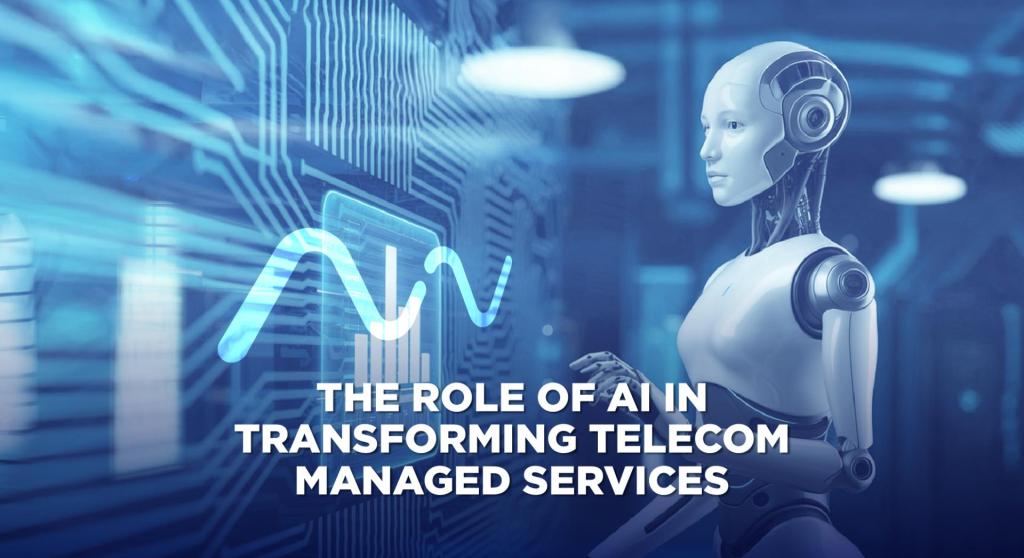Introduction: The Evolution of Telecom Managed Services
Telecom operators constantly face a range of challenges. From managing increasingly complex networks to meeting customers’ ever-growing demands, the pressure to maintain seamless and cost-effective services has never been higher. Traditional managed services, which focus on reactive troubleshooting and manual interventions, are no longer sufficient to address these evolving challenges. Operators are looking for more efficient, intelligent ways to manage their networks.
Enter Artificial Intelligence (AI), a game changer transforming how telecom-managed services operate. AI is revolutionizing key aspects such as service assurance and network optimization, enabling telecom companies to proactively manage their networks, enhance customer satisfaction, and reduce costs.
What Are Telecom Managed Services?
Telecom-managed services are a set of solutions that telecom operators rely on to ensure the efficient operation of their networks. These services typically include network monitoring, maintenance, and service assurance, which are crucial for ensuring the network runs smoothly and meets customer expectations.
With the complexity of modern telecom networks, the demand for automation and intelligence has become more critical than ever. Telecom operators now need solutions that can handle the growing volume of data, predict potential issues before they arise, and optimize resources to reduce operational costs while maintaining high service levels.
The Role of AI in Telecom Service Assurance
AI fundamentally reshapes telecom service assurance by enabling proactive monitoring and issue detection. Unlike traditional methods, which often involve reactive troubleshooting once problems arise, AI uses advanced analytics and machine learning algorithms to monitor network performance in real-time continuously.
AI-powered service assurance systems can automatically detect anomalies, predict service disruptions, and resolve issues before they affect end users. By leveraging real-time data and AI-driven insights, telecom operators can drastically reduce downtime, improve service quality, and enhance customer satisfaction.
AI can recognize patterns and trends in network performance that may foreshadow a future fault. It allows operators to take preemptive action, ensuring that service disruptions are minimized and customer experience is consistently optimized.

AI-Driven Network Optimization and Automation
AI-driven network optimization is another area where telecom operators can realize significant benefits. Telecom networks are becoming increasingly complex, with more devices and users connected than ever before. AI algorithms handle this complexity by analyzing large volumes of data from network traffic, usage patterns, and past performance to optimize network performance in real-time.
AI enables predictive maintenance, allowing operators to address potential issues before they cause service outages. By predicting which components will likely fail, AI helps prioritize maintenance tasks, ensuring optimal resource allocation and minimizing downtime.
Additionally, AI-driven automation is transforming the way networks operate. For instance, AI-driven self-healing networks can autonomously modify network settings to resolve performance challenges, while intelligent traffic routing optimizes the use of network resources. This level of automation frees engineers to concentrate on more strategic activities like network planning and innovation instead of being bogged down by everyday maintenance and problem-solving tasks.

AI-Driven Network Optimization and Automation
AI-driven network optimization is another area where telecom operators can realize significant benefits. Telecom networks are becoming increasingly complex, with more devices and users connected than ever before. AI algorithms handle this complexity by analyzing large volumes of data from network traffic, usage patterns, and past performance to optimize network performance in real-time.
AI enables predictive maintenance, allowing operators to address potential issues before they cause service outages.
By predicting which components will likely fail, AI helps prioritize maintenance tasks, ensuring optimal resource allocation and minimizing downtime.
Additionally, AI-driven automation is transforming the way networks operate. For instance, AI-driven self-healing networks can autonomously modify network settings to resolve performance challenges, while intelligent traffic routing optimizes the use of network resources. This level of automation frees engineers to concentrate on more strategic activities like network planning and innovation instead of being bogged down by everyday maintenance and problem-solving tasks.
Benefits of AI in Telecom Managed Services

Real-World Use Cases of AI in Telecom
Several telecom operators are already reaping the rewards of AI in their managed services. For example, major operators have deployed AI-powered service assurance platforms to detect and resolve network issues before they affect customers. These systems leverage ML and predictive analytics to continuously track network performance and detect potential problems before they escalate.
One notable success story is a telecom operator implementing AI-driven network optimization tools. By leveraging AI algorithms, the operator was able to reduce network outages, optimize traffic routing, and improve overall network performance. It led to cost savings while improving the customer experience by ensuring high service quality and reliability.
AI technologies like ML, natural language processing, and neural networks are becoming increasingly common in telecom networks, making them more efficient and self-sufficient.
Challenges and Considerations
While AI’s potential in telecom is immense, operators must address a few challenges. One key issue is data privacy. Telecom operators must ensure that AI solutions comply with data protection regulations, safeguarding sensitive customer information.
Another challenge is the integration of AI into legacy systems. Many telecom operators are working with older network infrastructure, and incorporating AI into these systems can be complex and costly. Operators must collaborate with experienced AI solution providers to ensure a smooth and successful transition.
Lastly, there is a growing need for skilled personnel who can manage and optimize AI systems. Telecom operators need to prioritize training and development to cultivate the essential skills and knowledge within their teams.
The Future of AI in Telecom Managed Services
The role of AI in telecom is poised to expand further. As 5G networks roll out, AI will play an even more significant role in managing network traffic, optimizing resources, and ensuring service continuity. In the future, we can expect AI-powered 5G networks, where AI will autonomously manage network configuration and optimization without human intervention.
Other emerging trends include edge computing, where AI will be used to process data closer to the source, improving latency and real-time decision-making. Autonomous networks powered by AI will also become a reality, allowing telecom operators to deliver a fully automated, self-healing network that operates with minimal human intervention.

The Future of AI in Telecom Managed Services
The role of AI in telecom is poised to expand further. As 5G networks roll out, AI will play an even more significant role in managing network traffic, optimizing resources, and ensuring service continuity. In the future, we can expect AI-powered 5G networks, where AI will autonomously manage network configuration and optimization without human intervention.
Other emerging trends include edge computing, where AI will be used to process data closer to the source, improving latency and real-time decision-making. Autonomous networks powered by AI will also become a reality, allowing telecom operators to deliver a fully automated, self-healing network that operates with minimal human intervention.
Adopting AI now is essential for telecom operators who want to stay ahead of the competition and prepare for the future of telecom services.
Conclusion: Embracing AI for Smarter Telecom Managed Services
AI transforms telecom-managed services by enhancing service assurance, optimizing network performance, and driving automation. As telecom networks become more complex and customer expectations rise, AI solutions equip operators with the capabilities to enhance efficiency, cut costs, and provide exceptional customer experiences.
Now is the time for mobile network operators to invest in AI-driven telecom solutions. Embracing these technologies will not only help them stay competitive but also enable them to provide more intelligent, more reliable services to their customers.
If you’re interested in exploring AI-powered telecom solutions or want to understand how AI can revolutionize your network management, reach out to us today to see how we can assist you.

